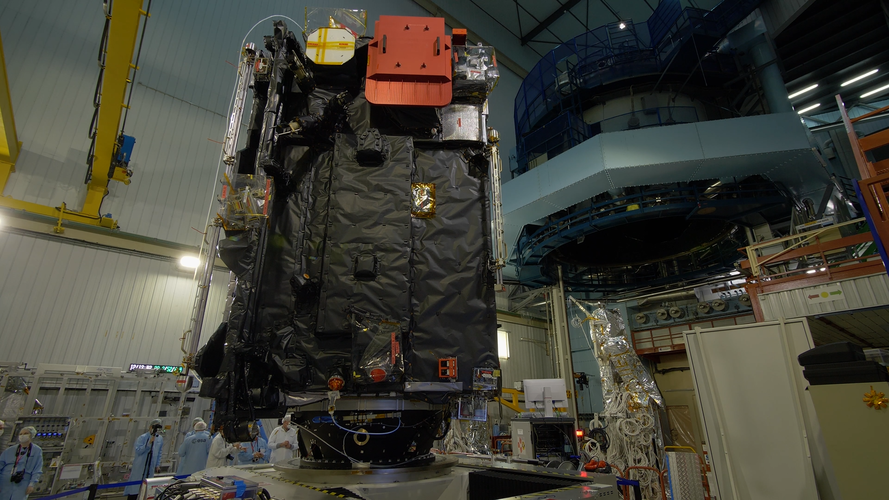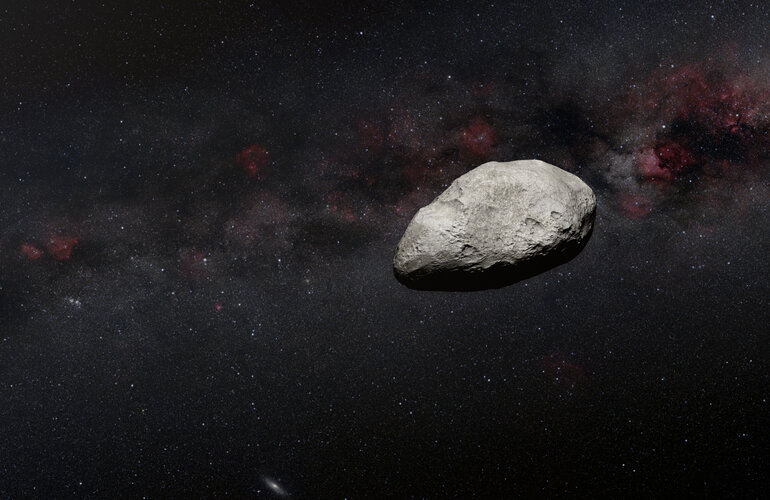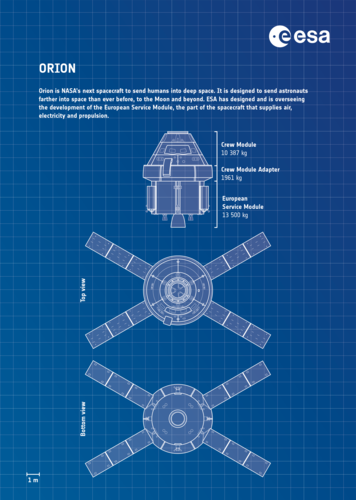
Copernical Team
Tuesday, 07 February 2023 04:44
Launches of Busek Thrusters push OneWeb constellation towards completion
Natick MA (SPX) Feb 07, 2023
 The in-space propulsion firm Busek Co. Inc. (Busek) announced the successful on-orbit commissioning of its BHT-350 Hall effect thrusters on a duo of launches. The thrusters were sent aloft on OneWeb's 15th and 16th missions, which utilized separate SpaceX Falcon-9s to deliver 80 spacecraft into low Earth orbit (LEO). The Busek thrusters are utilized for orbit-raising, station-keeping, collision
The in-space propulsion firm Busek Co. Inc. (Busek) announced the successful on-orbit commissioning of its BHT-350 Hall effect thrusters on a duo of launches. The thrusters were sent aloft on OneWeb's 15th and 16th missions, which utilized separate SpaceX Falcon-9s to deliver 80 spacecraft into low Earth orbit (LEO). The Busek thrusters are utilized for orbit-raising, station-keeping, collision
 The in-space propulsion firm Busek Co. Inc. (Busek) announced the successful on-orbit commissioning of its BHT-350 Hall effect thrusters on a duo of launches. The thrusters were sent aloft on OneWeb's 15th and 16th missions, which utilized separate SpaceX Falcon-9s to deliver 80 spacecraft into low Earth orbit (LEO). The Busek thrusters are utilized for orbit-raising, station-keeping, collision
The in-space propulsion firm Busek Co. Inc. (Busek) announced the successful on-orbit commissioning of its BHT-350 Hall effect thrusters on a duo of launches. The thrusters were sent aloft on OneWeb's 15th and 16th missions, which utilized separate SpaceX Falcon-9s to deliver 80 spacecraft into low Earth orbit (LEO). The Busek thrusters are utilized for orbit-raising, station-keeping, collision
Published in
News
Tagged under
Tuesday, 07 February 2023 04:44
SpaceX to try again to launch Hispasat Amazonas Nexus mission
Washington DC (UPI) Feb 6, 2021
 SpaceX is planning another launch attempt of the Hispasat Amazonas Nexus mission Monday evening after it was scrubbed on Sunday because of inclement weather.
The launch is set for 8:32 p.m. EST on Monday at Cape Canaveral Space Force Station in Florida on a SpaceX Falcon 9 rocket.
The satellite features Ka-band capacity to optimize communications between the gateways and the sate
SpaceX is planning another launch attempt of the Hispasat Amazonas Nexus mission Monday evening after it was scrubbed on Sunday because of inclement weather.
The launch is set for 8:32 p.m. EST on Monday at Cape Canaveral Space Force Station in Florida on a SpaceX Falcon 9 rocket.
The satellite features Ka-band capacity to optimize communications between the gateways and the sate
 SpaceX is planning another launch attempt of the Hispasat Amazonas Nexus mission Monday evening after it was scrubbed on Sunday because of inclement weather.
The launch is set for 8:32 p.m. EST on Monday at Cape Canaveral Space Force Station in Florida on a SpaceX Falcon 9 rocket.
The satellite features Ka-band capacity to optimize communications between the gateways and the sate
SpaceX is planning another launch attempt of the Hispasat Amazonas Nexus mission Monday evening after it was scrubbed on Sunday because of inclement weather.
The launch is set for 8:32 p.m. EST on Monday at Cape Canaveral Space Force Station in Florida on a SpaceX Falcon 9 rocket.
The satellite features Ka-band capacity to optimize communications between the gateways and the sate
Published in
News
Tagged under
Tuesday, 07 February 2023 04:44
Building a catalog to lunar trash to track
Tucson AZ (SPX) Feb 07, 2023
 Scientists and government agencies have been worried about the space junk surrounding Earth for decades. But humanity's starry ambitions are farther reaching than the space just around Earth. Ever since the 1960s with the launch of the Apollo program and the emergence of the space race between the U.S. and Soviet Union, people have been leaving trash around the Moon, too.
Today, experts es
Scientists and government agencies have been worried about the space junk surrounding Earth for decades. But humanity's starry ambitions are farther reaching than the space just around Earth. Ever since the 1960s with the launch of the Apollo program and the emergence of the space race between the U.S. and Soviet Union, people have been leaving trash around the Moon, too.
Today, experts es
 Scientists and government agencies have been worried about the space junk surrounding Earth for decades. But humanity's starry ambitions are farther reaching than the space just around Earth. Ever since the 1960s with the launch of the Apollo program and the emergence of the space race between the U.S. and Soviet Union, people have been leaving trash around the Moon, too.
Today, experts es
Scientists and government agencies have been worried about the space junk surrounding Earth for decades. But humanity's starry ambitions are farther reaching than the space just around Earth. Ever since the 1960s with the launch of the Apollo program and the emergence of the space race between the U.S. and Soviet Union, people have been leaving trash around the Moon, too.
Today, experts es
Published in
News
Tagged under
Tuesday, 07 February 2023 04:44
China to advance lunar exploration program
Beijing (XNA) Feb 07, 2023
 China will push forward its phase-4 lunar exploration program this year, including a planned mission to bring 2 kilograms of samples from the far side of the moon back to Earth, Wu Weiren, chief designer of the country's lunar exploration program, revealed on Monday.
Wu said China will continue its lunar research with the Chang'e-6, Chang'e-7 and Chang'e-8 missions. The Chang'e-6 mission i
China will push forward its phase-4 lunar exploration program this year, including a planned mission to bring 2 kilograms of samples from the far side of the moon back to Earth, Wu Weiren, chief designer of the country's lunar exploration program, revealed on Monday.
Wu said China will continue its lunar research with the Chang'e-6, Chang'e-7 and Chang'e-8 missions. The Chang'e-6 mission i
 China will push forward its phase-4 lunar exploration program this year, including a planned mission to bring 2 kilograms of samples from the far side of the moon back to Earth, Wu Weiren, chief designer of the country's lunar exploration program, revealed on Monday.
Wu said China will continue its lunar research with the Chang'e-6, Chang'e-7 and Chang'e-8 missions. The Chang'e-6 mission i
China will push forward its phase-4 lunar exploration program this year, including a planned mission to bring 2 kilograms of samples from the far side of the moon back to Earth, Wu Weiren, chief designer of the country's lunar exploration program, revealed on Monday.
Wu said China will continue its lunar research with the Chang'e-6, Chang'e-7 and Chang'e-8 missions. The Chang'e-6 mission i
Published in
News
Tagged under
Tuesday, 07 February 2023 04:44
Distant galaxy mirrors the early Milky Way
London, UK (SPX) Feb 07, 2023
 A galaxy has been discovered that mirrors the very early version of our home galaxy, the Milky Way. The galaxy, dubbed 'The Sparkler', is embedded in a system of globular clusters and satellite galaxies, and appears to be swallowing them as it grows. The research was published in Monthly Notices of the Royal Astronomical Society.
The discovery of The Sparkler was made using some of the fir
A galaxy has been discovered that mirrors the very early version of our home galaxy, the Milky Way. The galaxy, dubbed 'The Sparkler', is embedded in a system of globular clusters and satellite galaxies, and appears to be swallowing them as it grows. The research was published in Monthly Notices of the Royal Astronomical Society.
The discovery of The Sparkler was made using some of the fir
 A galaxy has been discovered that mirrors the very early version of our home galaxy, the Milky Way. The galaxy, dubbed 'The Sparkler', is embedded in a system of globular clusters and satellite galaxies, and appears to be swallowing them as it grows. The research was published in Monthly Notices of the Royal Astronomical Society.
The discovery of The Sparkler was made using some of the fir
A galaxy has been discovered that mirrors the very early version of our home galaxy, the Milky Way. The galaxy, dubbed 'The Sparkler', is embedded in a system of globular clusters and satellite galaxies, and appears to be swallowing them as it grows. The research was published in Monthly Notices of the Royal Astronomical Society.
The discovery of The Sparkler was made using some of the fir
Published in
News
Tagged under
Monday, 06 February 2023 11:24
The Making of Juice – Episode 9
 Video:
00:05:36
Five-minute behind-the-scenes documentary covering the story behind the application of the Galileo tribute plaque to ESA’s Juice spacecraft.
Video:
00:05:36
Five-minute behind-the-scenes documentary covering the story behind the application of the Galileo tribute plaque to ESA’s Juice spacecraft.
Published in
News
Tagged under
Monday, 06 February 2023 15:00
Webb detects extremely small main-belt asteroid

A previously unknown 100–200-metre asteroid — roughly the size of Rome’s Colosseum — has been detected by an international team of European astronomers using the NASA/ESA/CSA James Webb Space Telescope. Their project used data from the calibration of the Mid-InfraRed Instrument (MIRI), in which the team serendipitously detected an interloping asteroid. The object is likely the smallest observed to date by Webb and may be an example of an object measuring under 1 kilometer in length within the main asteroid belt, located between Mars and Jupiter. More observations are needed to better characterize this object’s nature and properties.
Published in
News
Tagged under
Monday, 06 February 2023 12:30
Orion blueprint
 Image:
Orion blueprint
Image:
Orion blueprint
Published in
News
Tagged under
Monday, 06 February 2023 00:38
SpaceX delays Hispasat Amazonas Nexus launch
Washington DC (UPI) Feb 5, 2021
 SpaceX will delay the launch of the Hispasat Amazonas Nexus mission until Monday at 5:32 p.m. EST, after unfavorable weather conditions held up Sunday's planned launch.
The rocket was scheduled to lift off at 5:32 p.m. EST on Sunday from Cape Canaveral Space Force Station in Florida. It was initially delayed by two hours as conditions were 30% favorable for lift off, SpaceX said. It was
SpaceX will delay the launch of the Hispasat Amazonas Nexus mission until Monday at 5:32 p.m. EST, after unfavorable weather conditions held up Sunday's planned launch.
The rocket was scheduled to lift off at 5:32 p.m. EST on Sunday from Cape Canaveral Space Force Station in Florida. It was initially delayed by two hours as conditions were 30% favorable for lift off, SpaceX said. It was
 SpaceX will delay the launch of the Hispasat Amazonas Nexus mission until Monday at 5:32 p.m. EST, after unfavorable weather conditions held up Sunday's planned launch.
The rocket was scheduled to lift off at 5:32 p.m. EST on Sunday from Cape Canaveral Space Force Station in Florida. It was initially delayed by two hours as conditions were 30% favorable for lift off, SpaceX said. It was
SpaceX will delay the launch of the Hispasat Amazonas Nexus mission until Monday at 5:32 p.m. EST, after unfavorable weather conditions held up Sunday's planned launch.
The rocket was scheduled to lift off at 5:32 p.m. EST on Sunday from Cape Canaveral Space Force Station in Florida. It was initially delayed by two hours as conditions were 30% favorable for lift off, SpaceX said. It was
Published in
News
Tagged under
Sunday, 05 February 2023 10:54
Physicists observe rare resonance in molecules for the first time
Boston MA (SPX) Feb 03, 2023
 If she hits just the right pitch, a singer can shatter a wine glass. The reason is resonance. While the glass may vibrate slightly in response to most acoustic tones, a pitch that resonates with the material's own natural frequency can send its vibrations into overdrive, causing the glass to shatter.
Resonance also occurs at the much smaller scale of atoms and molecules. When particles che
If she hits just the right pitch, a singer can shatter a wine glass. The reason is resonance. While the glass may vibrate slightly in response to most acoustic tones, a pitch that resonates with the material's own natural frequency can send its vibrations into overdrive, causing the glass to shatter.
Resonance also occurs at the much smaller scale of atoms and molecules. When particles che
 If she hits just the right pitch, a singer can shatter a wine glass. The reason is resonance. While the glass may vibrate slightly in response to most acoustic tones, a pitch that resonates with the material's own natural frequency can send its vibrations into overdrive, causing the glass to shatter.
Resonance also occurs at the much smaller scale of atoms and molecules. When particles che
If she hits just the right pitch, a singer can shatter a wine glass. The reason is resonance. While the glass may vibrate slightly in response to most acoustic tones, a pitch that resonates with the material's own natural frequency can send its vibrations into overdrive, causing the glass to shatter.
Resonance also occurs at the much smaller scale of atoms and molecules. When particles che
Published in
News
Tagged under

